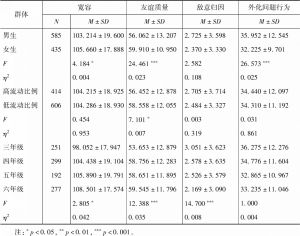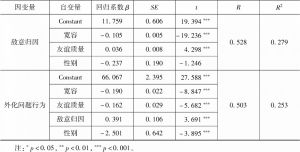论文
宽容对小学生外化问题行为的影响:友谊质量、敌意归因的中介作用
摘要
为探讨宽容品质在约束小学生外化问题行为方面的道德功能,探讨友谊质量和敌意归因在小学生宽容品质对外化问题行为影响过程中的中介作用。本研究采用《儿童青少年问题行为量表》《小学生宽容量表》《友谊质量问卷》《敌意归因偏向问卷》,对武汉市两所小学三年级至六年级学生进行问卷调查,有效问卷共计1020份。利用SPSS软件中Process插件Bootstrap方法进行中介效应检验,结果发现:宽容、友谊质量、敌意归因以及外化问题行为四者均呈显著相关;宽容既可以直接减弱外化问题行为,也可以分别通过友谊质量、敌意归因这两条中介路径间接减弱外化问题行为。研究证实了宽容作为积极道德品质对于小学生外化问题行为这一消极道德行为的抑制作用。宽容是对小学生来说具有德育价值的积极道德品质。
作者
张春妹 ,博士,武汉大学哲学学院心理学副教授、博士生导师,武汉大学珞珈青年学者。武汉大学“70后”学术团队建设项目“当代文化心理学研究”负责人,主编“文化心理学精品译丛”;个人专著入选武汉大学社会人文学术丛书,译著《文化心理学》入选中国社会心理学会2020年30本好书、《牛津中国心理学手册》入选人民出版社2019年度十大优秀著作;MOOC《发展心理学》获批2020年度国家首批一流本科线上课程,专业课《发展心理学》2021年获批湖北省一流线上线下混合课程。主持国家社科基金、教育部人文社科基金、教育部人文社科重点研究基地重大项目子项目等10余项。
张安琪 ,武汉大学哲学学院心理学系2019级研究生。
朱小玲 ,武汉市三眼桥小学教师。
杜丽虹 ,武汉市三眼桥小学高级教师。
检索正文关键字
论文目录
-
一 问题提出
- (一)宽容作为道德品质的概念
- (二)宽容品质与外化问题行为的关系
- (三)友谊质量和敌意归因的中介作用
-
二 研究方法
- (一)被试
- (二)研究程序与工具
- 1.基本信息问卷
- 2.儿童青少年问题行为量表
- 3.小学生宽容量表
- 4.友谊质量问卷
- 5.敌意归因偏向问卷
- 6.统计分析
-
三 结果
- (一)共同方法偏差
- (二)方差分析和相关分析
- (三)回归分析
- (四)中介效应检验
-
四 讨论
- (一)小学生宽容、友谊质量、外化问题行为、敌意归因的特点
- (二)宽容对小学生外化问题行为具有抑制作用
- (三)友谊质量、敌意归因在宽容与小学生外化问题行为之间起到中介作用
- (四)启示与不足
相关文献
宽容对小学生外化问题行为的影响:友谊质量、敌意归因的中介作用
程序公平性和结果有利性对儿童程序正义判断、结果满意度与权威接纳意愿的影响
查看更多>>>








